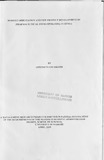| dc.description.abstract | Discovering and commercialsing of new drug molecules is critical for the
future assets of a pharmaceutical company. However, bringing a molecule
from discovery to manufacturing is a long and costly process that implicates
several phases: Three development clinical test phases, Phase I to Phase III,
the filing of a New Drug Application, NDA, and the final approval by
governmental regulatory authorities. Thereafter, manufacturing starts and
eventually a phase IV trial is conducted to further analyze side effects on
larger populations, and the company finally realizes return on its investment
(WHO,ASEAN TRIPS report,2006).After having decided to launch a discovered
molecule into the development pipeline, the company is able, at any moment
to reevaluate the interest of ,one, Continuing the process ,two, Selling the
molecule to another company and getting back the research investment
,three, Subcontracting partially or totally the remaining process to complete
the research phases until NDA and Manufacturing .
Once the new product begins to be manufactured, the company has to
schedule this new production and has the choice between 3 possibilities,
Integrating this new production into the existing production capacities,
and/or Planning to extend the production capacities to adjust it to the new
requirements and/or decision to subcontract partially or in totality the
production of this product. In this case, early contacts have to be taken with
the partner, selected upon his capabilities, financial health, knowledge and
experience according the product to be manufactured. Products originating
from this route are usually “branded original” products. These products
usually have World Trade Organization patent protection for periods of up to
15 years. The product is then availed globally through applications to individual country regulatory authorities which review scientific evidence of efficacy and safety before being authorized for sale in such markets (WHO,ASEAN TRIPS report,2006).Other companies will not go through such a process. They will copy formulations of already licensed products, depending on patent protection and commercial success. Using replicated data from phase I –IV tests, they will submit their “generics” for commercialization
approval by regulatory authorities who only subject such generics to quality
tests (WHO,ASEAN TRIPS report,2006). | en |

